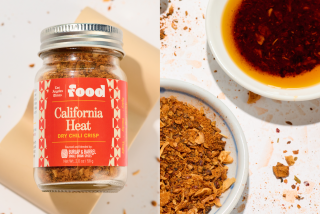200 Years Later, Spice Trade Still Has Flavor of Success
SALEM, Mass. — More than two centuries ago, a bold young sea captain named Jonathan Carnes set sail from Salem to Sumatra to secure pepper, nutmeg and enough contacts to propel America into the lucrative spice trade.
Today, the spice business has lost some of its romance: brokers negotiate with sellers via faxes, airplanes are used instead of wooden ships, taxes are no longer payable in pepper, and spice traders have all but disappeared from the docks of Salem and other New England cities.
But in Massachusetts and other parts of the country, spices remain a profitable venture, their exotic appeal adapted to fit the business world of the ‘90s.
“The essence of the spice trade has not really changed but it’s definitely gotten larger, more specialized, said Joel S. Darack, vice president of the Dirigo Spice Corp. in Boston’s Dorchester neighborhood.
The company is one of the last remaining traditional spice companies in New England, where the American spice trade was launched.
Dirigo started as a small company in the 1920s that provided spices to meat packagers.
Now the company needs a huge warehouse to meet the demands of its customers, which include food wholesalers, distributors, barbecue chains and customers wanting something unique, such as Dirigo’s special concoction to make cat food taste better: “Catphrodisiac.”
The specialty requests are something that allows the industry to keep reinventing itself, says Anita Fial, American Spice Trade Association spokeswoman.
“Americans are always looking for new flavors, new types of cuisines, or new ways to flavor bland, fat-free foods,” she said. “Spice is still mysterious. But it’s a business that just keeps doing better over time.”
Most of the spice consumed in the U.S. still comes from other countries--cinnamon from China, pepper from Brazil, saffron from Spain--but Americans have become the No. 1 spice consumers in the world. In addition, the U.S. is home to the world’s largest spice manufacturer, McCormick & Co., which had 1997 sales of $1.8 billion selling its spices under the name Schilling west of Mississippi, Club House in Canada and Schwartz in the United Kingdom.
Since 1961, consumption in the U.S. has increased more than 126% and the American Spice Trade Association predicts its April figures will reflect yet another increase since the last numbers released in 1996.
The allure of spice caught on soon after the journey of Capt. Carnes, who risked the dangers of the sea and pirates to circumvent a Dutch spice monopoly.
The trip sent the nation into the spice trade so aggressively that roughly a thousand vessels made the same journey to Sumatra between 1784 and 1873.
As the demand for spices grew in the 1800s, so did the need for bigger ships to carry larger cargoes. As that happened, sea captains looked toward New York, which had a deeper port that was easier to navigate, said William LaMoy, a librarian at the Peabody Essex Museum in Salem.
Today, there’s little visible evidence that America’s launch into the spice trade occurred in Salem.
“There is nothing other than the wharf and the old Customs House here that would indicate how much commercial spice trade there was during the start of the 1800s,” LaMoy said.
The National Parks Service recently decided to signify the importance of Salem in the spice trade by recreating the Friendship, a 171-foot merchant ship that led in opening the spice trade in the Far East.
The ship is expected to be complete in two years. But unlike its ancestors, which crossed oceans in search of special spices, this one will remain as a teaching icon.
Modern times have meant easier access to exotic crops, which has translated to cheaper prices.
In the 11th century, a bag of pepper was worth a man’s life in some countries and some spices were valuable enough to use as ransom payment or taxes, Fial said.
Although the taxman isn’t accepting pepper as payment these days and hostages aren’t likely to be released for a bag of coriander, some spices like saffron--the world’s most expensive spice--have retained value and stature.
Saffron, made from a variety of crocus, takes more than 225,000 flowers to make a pound. With an ounce of the spice costing at least $40, some grocery stores have stopped carrying it because it is stolen off the shelves, Fial said.
“Saffron is one of the spices we immediately associate as exotic, and a lot of that has to do with its value and also that many of these ethnic recipes call for it,” she said.
Dirigo officials say they get few spice shipments direct to ports in Massachusetts, but they do still deal directly with contacts in Spain for the pricey saffron.
“Most of it comes from New York, sometimes by plane, rail, or even by mail,” said John Darack, of Dirigo.
Equipped with high-tech testing equipment and monstrous metal mixers, Dirigo buys, grinds, mixes and hand-packages spices from parsley to turmeric for wholesalers in the U.S.
Customer requests range from 2-pound plastic cans to 60-pound bags of blends.
Food manufacturers and processors have learned to rely on distinctive spicing to make their products more flavorful.
And because Americans are so fickle in their tastes, the Daracks say they’re confident the business will grow.
“Luckily, there’s always room for growth in the spice business,” said Joel Darack.


